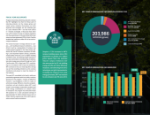
The Path to 2050
Progress toward decarbonizing a dynamic campus like MIT highlights the often-non-linear path of reducing emissions. As the campus grows and needs evolve, emissions fluctuations are both expected and managed for, but the ultimate goal of a zero emissions MIT—and the work toward it—remains unchanged. In fiscal year 2022, there was a 5% increase in total on-campus emissions over the previous year. In this same time, MIT’s solar power purchase agreement (PPA) in North Carolina enabled the Institute to offset 11% of its total on-campus emissions.
The overall increase in energy demand on campus—and resulting increase in emissions—was driven in part by a repopulation of campus, new campus growth (related to the New Vassar, the MIT Museum, expansion of Building 4, and reopened Hayden Library), pandemic related safety measures, such as higher building ventilation rates, and testing energy required for the new central plant commissioning. In addition, less solar energy was produced through our North Carolina solar PPA in fiscal year 2022, contributing to an increase in MIT’s total net emissions. MIT continues to focus on reducing direct energy use and the resulting emissions as the campus transforms and grows to meet the mission of the Institute.
This year MIT committed to its fourth, multi-year partnership agreement with local utility company Eversource. The program—known as Efficiency Forward—was designed in 2010 to create an enhanced energy efficiency incentive program, creating a win-win situation where MIT could invest in more energy conservation projects and lower energy consumption on campus. Since its inception, the program has executed nearly 300 projects for a total calculated savings of approximately 70 million kilowatt hours and 4.2 million therms, playing a key role in MIT’s goal to reduce overall carbon emissions.


